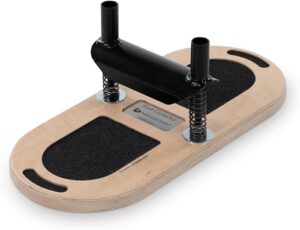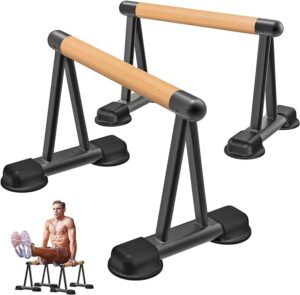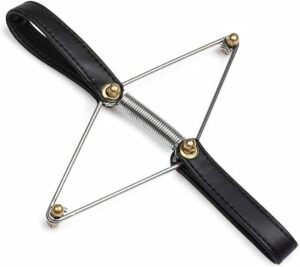When most people think of Pilates, they picture the Reformer, Cadillac, or Wunda Chair. However, there are smaller, lesser-known pieces of apparatus that can elevate your home practice and target specific areas with incredible precision. In this post, we’ll dive into four of these tools: push-up devices, the toe corrector, the foot corrector, and the sandbag. We’ll cover the benefits, the body parts they work on, exercises to try, and our top selections from Amazon to help you get started.
Benefits:
Push-up devices are designed to provide enhanced support and stability during upper body exercises. By using these devices, you can maintain proper wrist alignment, reduce the risk of strain, and allow for a deeper range of motion. They also help engage the muscles more effectively by allowing you to focus on form.
Body Parts Worked:
Push-up devices primarily target the chest, shoulders, triceps, and core. They also help to stabilize and strengthen the wrists and forearms.
Exercise: Push-Up on Devices
- Setup: Place the push-up devices shoulder-width apart on your mat.
- Position: Start in a plank position, gripping the handles firmly, with your body in a straight line from head to heels.
- Action: Inhale as you lower your body towards the mat, bending your elbows to a 90-degree angle.
- Return: Exhale as you press back up to the starting position, keeping your core engaged.
Variation:
For an added challenge, try a single-leg push-up by lifting one leg off the ground as you perform the movement.
2. Toe Corrector: Enhance Foot Mobility, Alignment, and Posture
Benefits:
The toe corrector is a small but mighty tool designed to strengthen the toes, improve foot alignment, and enhance overall foot mobility. Regular use of the toe corrector can help prevent foot-related issues, reduce bunions, improve balance, and contribute to better posture by ensuring that your feet are properly aligned and strong.
Body Parts Worked:
The toe corrector primarily targets the muscles in the toes, feet, and lower legs. It also helps improve the alignment of the entire foot and can have a positive impact on posture. A leg spring workout in the palm of your hand that works from your feet to your seat!
Exercise: Toe Squeeze and Stretch
- Setup: Sit on a chair with your feet flat on the ground.
- Position: Place the toe corrector around your big toes, keeping your feet parallel.
- Action: Press your big toes outward against the resistance of the corrector, then release.
- Repeat: Perform 10-15 repetitions, focusing on controlled movements.
Tip:
This exercise can also be done seated with legs straight out in front of you or standing for an added balance challenge.
Get one here OR make your own with 2 heavy duty rubber bands like you would find on broccoli.
3. Foot Corrector: Strengthen Arches, Improve Foot Mechanics, and Alleviate Discomfort
Benefits:
The foot corrector is a compact device designed to strengthen the arches of your feet and improve overall foot mechanics. This tool is particularly beneficial for those who suffer from flat feet, plantar fasciitis, or other foot discomforts. Strengthening the arches can also enhance balance and stability, reduce foot pain, and improve alignment throughout the entire body.
Body Parts Worked:
The foot corrector primarily targets the arches of the feet, but it also works on the ankles, calves, and can have a ripple effect on the knees, hips, and lower back by improving foot alignment.
Exercise: Arch Press
- Setup: Stand with the foot corrector placed on the floor in front of you.
- Position: Place the ball of your foot on the center of the corrector, with your heel resting on the device.
- Action: Press down through the ball of your foot, engaging the arch as you push against the resistance.
- Return: Slowly release the pressure and return to the starting position.
- Repeat: Perform 10-15 repetitions for each foot.
Tip:
This exercise can be done seated for more support.
Get one here OR make your own by using a tennis ball. Not as much tension but will work the same way.
4. Sandbag: Build Wrist, Hand, and Shoulder Strength
Benefits:
The sandbag in Pilates is a unique tool tied to a long rope attached to a bar. It’s used to build strength in the wrists, hands, and shoulders through a controlled rolling motion. This apparatus is particularly beneficial for enhancing grip strength and improving the stability of the wrist and shoulder joints. It’s an excellent addition for anyone looking to strengthen these areas and improve overall upper body endurance.
Body Parts Worked:
The sandbag primarily targets the wrists, hands, forearms, and shoulders. It also engages the upper back and can contribute to better shoulder stability and control.
Exercise: Sandbag Roll-Up
- Setup: Stand with your feet shoulder-width apart, holding the bar with both hands in front of you, palms down.
- Position: Let the sandbag hang freely from the rope.
- Action: Begin to slowly roll the rope up the bar by rotating your wrists, bringing the sandbag up towards the bar.
- Reverse: Once the sandbag reaches the top, reverse the motion and slowly lower it back down by unrolling the rope.
- Repeat: Perform 2-3 sets, focusing on controlled movements and maintaining tension in the wrists and shoulders.
Tip:
Keep your core engaged throughout the exercise to maintain proper posture and avoid straining your lower back.
Get one here OR make your own by tying a string around a jug or bag filled with sand or marbles and attach to a pole.
Incorporating These Tools into Your Routine
These smaller pieces of Pilates apparatus can easily be integrated into your home workout routine. Whether you’re looking to refine your push-ups, strengthen your toes, improve your foot mechanics, or build wrist and shoulder strength, these tools offer targeted workouts that deliver noticeable results. Best of all, they are compact, making them perfect for home use.
Ready to take your Pilates practice to the next level? Use the links above to get started and book a virtual lesson today!
Tags: #PilatesAtHome #FitnessEnthusiast #HealthyLiving #PilatesEquipment #StrengthTraining #HomeWorkout #InjuryPrevention #CoreStrength #BetterBalance




